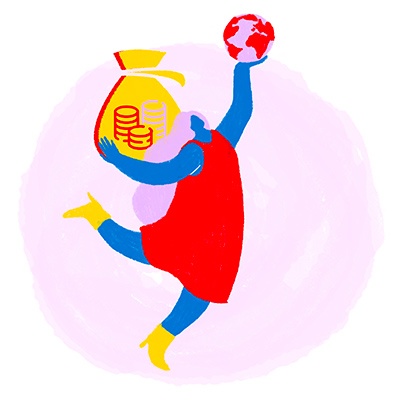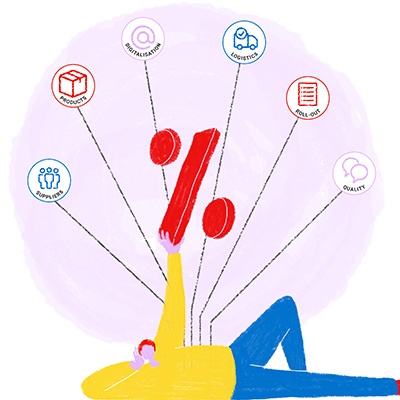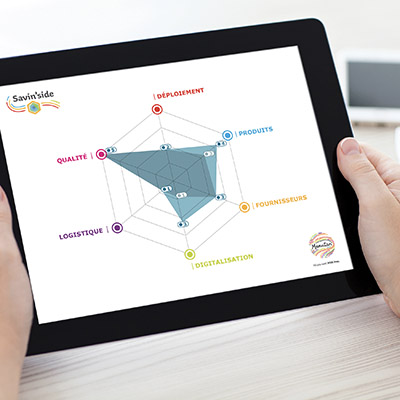To tackle the major environmental challenges of our century, more and more businesses are initiating their transition towards a more sustainable system, drawing on the circular economy. This model promotes an economy respectful of planetary boundaries, consuming fewer resources, emitting less greenhouse gases and reducing waste. Discover two examples of circular economy in companies that have adopted these principles at the heart of their business model.
The circular economy: Definition
The United Nations shares a complete definition of the circular economy: "The circular economy is a production, exchange and sharing system enabling social progress, the preservation of natural capital and economic development as defined by the Brundtland Commission. Its ultimate aim is to disconnect economic growth from the depletion of natural resources by creating innovative products, services, business models and public policies, taking into account all flows throughout the life of a product or service. This model is based on optimum use of resources and on creating positive value loops. It focuses on new design, production and consumption methods, extending the service life of products, and the refurbishing and recycling of components."
While the circular economy has long been confined to the sole lever of recycling and waste management, this concept covers many other areas of action, namely:
· Sustainable sourcing of raw materials;
· Eco-design of products;
· Industrial ecology;
· The service economy;
· Sustainable consumption;
· Extending product lifespan.
Today, many businesses are committing to the circular economy in the face of climate change and resource depletion. Some adopt a circular model from their creation, while others must transition from a linear to a circular model by making profound changes.
What is a circular business model?
A business model defines how a company creates, delivers and captures value. It then mobilises all its human, financial and/or material resources to achieve this purpose.
In a linear model based on the old productivist "extract - produce - discard" system, value is generally focused on the company’s economic and financial interests. On the other hand, a circular model takes into account social and environmental aspects, in addition to economic aspects, to create sustainable and regenerative value.
In this dynamic, the idea is to integrate all the circular economy principles at the heart of the organisation:
· Optimising its resources by extracting fewer virgin raw materials;
· Mutualising by favouring the local economy and cooperation between the supply chain stakeholders;
· Recovering its waste by creating new revenue streams and/or resource uses;
· Regenerating natural ecosystems and communities.
Circular economy: The example of a company born circular
Some companies place the circular economy at the very heart of their business model from their creation. This is the story of Winnow, which decided to use technology to serve a major environmental and economic issue: Food waste.
The London-based company started from a simple observation: Food waste costs the hospitality industry more than $100 billion per year. At the heart of this problem are kitchens, which can waste up to 20% of the food they purchase, often equivalent to their total net profits.
The solution? An easy-to-install technology that collects digital data and provides detailed reports to kitchens about their own food waste. This innovation includes a scale installed under the kitchen bin, as well as a method (powered by artificial intelligence or manually) to identify the type of food being thrown away. This allows chefs to analyse their waste and improve decision-making regarding menu design or food preparation, for example. Winnow, for its part, earns revenue via monthly service fees. Once the system is established, a typical customer can expect to reduce their waste by an average of 40 to 70%[1].
To date, the company saves the equivalent of 36 million meals from the bin each year. This equates to saving $43 million and avoiding 61,000 tonnes of carbon emissions1.
H2 - Circular economy: The example of a company in full transition
Simultaneously, some companies are implementing a circular economy strategy at the heart of their activities, with the aim of transforming their business model. This is the case of Philips, a global medical technology company, which is committed to the shift to a circular economy.
The ageing population, coupled with the continued rise in chronic diseases, emphasises the need to develop sustainable models for healthcare provision. It is based on this observation that the Dutch healthcare giant decided to adopt a circular approach to serve a more efficient healthcare system. In this regard, Harald Tepper, head of the circular economy programme at Philips, points out: "Working for healthy people and a healthy planet are two sides of the same coin."
Its circular transformation is based in particular on three main levers:
· Taking back and recovering (restoring or recycling) medical equipment from its clients;
· Optimising product and solution design to increase energy efficiency, reduce emissions and packaging;
· Offering new commercial models focused on services, based on duration, use and results.
In 2022, the share of circular products, services and solutions represented 18% of its turnover. By 2025, the ambition is to reach a 25% share of turnover, offer to take back all professional medical equipment and design all new products in accordance with their eco-design requirements2.
These examples remind us that the circular economy is not just a theoretical concept, but an economic reality. Whether from their creation or by adapting their model, any company can incorporate circular principles and thus engage in a dynamic of sustainable development. This is a great opportunity to position yourself as an agent of change within your ecosystem and make sustainability a driver of economic success.
[1] Ellen MacArthur Foundation, Reducing waste, increasing profits: Winnow, 2021





_1110x555.jpeg)


